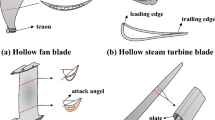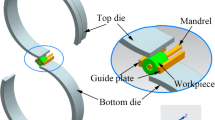Abstract
Both the mass and centrifugal force can be reduced by the hollow structure in blade. Also, the working efficiency of the engine can be improved by this hollow structure, but this structure is complicated and difficult to be formed. A pressing process of hollow blade with low melting point alloy as mandrel is proposed. The results show that the shape of the hollow blade can be controlled better by filling the low melting point alloy. The supporting structure has a great influence on the forming effect of unfilled low melting point alloy blade. The more supporting structures, the better the forming effect. The interface between the blade and the low melting point alloy cannot be bonded, so this processing method can be applied to practical production.
Graphical abstract

















Similar content being viewed by others
Data availability
The datasets generated and/or analyzed during the current study are available from the corresponding author on reasonable request.
References
Huang CH, Gau CW (2012) An optimal design for axial-flow fan blade: theoretical and experimental studies. J Mech Sci Technol 26(2):427–436
Schubel PJ, Crossley RJ (2012) Wind Turbine Blade Design. Energies 5(9):3425–3449
Xu L, Bo S, Hongde Y et al (2015) Evolution of Rolls-royce air-cooled turbine blades and feature analysis. Procedia Eng 99:1482–1491
Garzon VE, Darmofal DL (2003) Impact of geometric variability on axial compressor performance. J Turbomach 125(4):1199–1213
Vatanmakan M, Lakzian E, Mahpeykar MR (2018) Investigating the entropy generation in condensing steam flow in turbine blades with volumetric heating. Energy 147:701–714
Iqbal M, Wasy A, Batani D et al (2012) Design modification in rotor blade of turbo molecular pump. Nucl Instrum Methods Phys Res A 678:88–90
Li X, Yu JH, Zhao P (2016) Research status of deformation control technology for aero-engine blade machining. Aeronaut Manuf Technol 59(21):41–49
Galleguillos C, Zorrilla A, Jimenez A et al (2015) Thermographic non-destructive inspection of wind turbine blades using unmanned aerial systems. Plast Rubber Compos 44(3):98–103
Wu XC, Chen MH, Xie LS, Zhang TL, Hu ZH (2015) Bending and torsion forming of TC4 titanium alloy wide-chord hollow fan blades for aero-engine with complex shape. Acta Aeronaut Sin 36(6):2055–2063
Liang CH, Yang R (1999) The development and application of aero-engine wide-chord hollow fan blades. Aeroengine 02:54–58
Liang CH (2006) Review on advanced fan and compressor blades for high performance aero-engine. Aeroengine 03:48–52
Yang JQ, Wang YR (2011) Optimization design of hollow blade structure based on orthogonal experimental design. J Aerosp Power 26(2):376–384
Ma RL (2013) Performance analysis and optimization design of self induced trailing edge air-jet hollow rotor blade. Huazhong University of Science and Technology
Li SF, Zhang DH, Bu K (2012) Research progress of precise shape control technology for single crystal hollow turbine blades. Rare Metal Mater Eng 41(03):559–564
Wang DL, Li JB, Jin T, Yang SQ, Wei Zh, Hu ZQ, Fu LQ (2006) Recrystallization of DZ4 nickel-based superalloy. Acta Metall Sin 2:167–171
Fu Y, Hang G, Wang X et al (2017) Machining the integral impeller and blisk of aero-engines: a review of surface finishing and strengthening technologies. Chin J Mech Eng 30(03):528–543
Xu JH, Zhao ZG, Fu YC et al (2014) The key technology of CNC machining of titanium alloy wide-chord hollow fan blades. J Nanjing Univ Aeronaut Astronaut 46(5):659–666
Chai XH, Zhang XY, Shi TC (2014) Superplastic forming/diffusion joint weld failure and fracture simulation method. J Shanghai Jiaotong Univ Chin Ed 48(04):532–537
Gao S, Tan ZJ, Lan L, He B (2020) Effects of geometrical size and structural feature on the shape-distortion behavior of hollow Ti-alloy blade fabricated by additive manufacturing process. J Laser Appl 32(3):032005
Mao J, Meng H, Chen HY, Zhang Y (2013) Comparative analysis and research on hot rolling and cold rolling processes of aeroengine blades. Hot Work Process 42(13):84–86
Zhao XL, Li C, Liao XW, Xu M (2014) Application of low melting point alloys in thin-walled parts processing. Metalwork Cold Work 2:28–29
Chen XH (2018) The application of low melting point alloy infusion in the processing of thin-walled shell parts. The 21st Annual Academic Conference of the Vacuum Electronics Branch of the Chinese Institute of Electronics 749–750
Sedighi M, Kahnamouei JT (2014) Role of filling material on defects of thin-walled tube bending process. J Theor Appl Mech 52(1):227–233
Zhao CG (2006) Research on the application of low melting point alloy in the manufacturing of complex thin-walled parts. Aerosp Manuf Technol 2:15–18
Shan DB, Yuan L, Lv Y (2007) Mechanical characteristics of extrusion bulging of aluminum alloy tube blank in low melting point plastic medium. J Harbin Inst Technol 01:69–72
Yu KH, Yue ZF (2007) Parametric modeling and multidisciplinary design optimization of turbine cooling blades. J Aeronaut Power 8:1346–1351
Kong XW, Li J, Li B (2013) Finite element analysis of rolling process for variable cross-section blade. J Cent South Univ 20(12):3431–3436
Kong XW, Wang HY, Jiang L, Ma L, Sun JC (2020) Research on rolling force and stress during rolling process of blade with complex surface based on multi-plane slab method. J Braz Soc Mech Sci Eng 42:393
Zhao YH, Yang JX (2020) Stamping process of stainless steel curved beam with hat-shaped section of rail vehicles. Forg Technol 45(12):72–77
Ye YN, Ming C, Shi HZ (2015) Effect of cold rolling parameters on the longitudinal residual stress distribution of GH4169 alloy sheet. Acta Metall Sin Engl Lett 28(12):1510–1517
Zhao XB, Gu YF, Lu JT, Yan JB, Yin HF (2015) New progress in the research of GH4169 alloy. Rare Metal Mater Eng 44(3):768–774
Chen C, Liu JS, Zhang SH, Cheng M, Tai QG, Guo ZX (2014) Finite element simulation analysis of cold rolling of an alloy blade. Forg Technol 39(8):42–46
Guo XH, Cheng C, Xu Y, Tao J, El-Aty AA, Liu H (2020) Finite element modelling and experimental investigation of the impact of filling different materials in copper tubes during 3D free bending process. Chin J Aeronaut 33(2):721–729
Funding
This work is financially supported by the National Natural Science Foundation of China No. 51905068, Natural Science Foundation of Liaoning Province No.2020-HYLH-24, the open research fund from the State Key Laboratory of Rolling and Automation, Northeastern University No. 2020RALKFKT012.
Author information
Authors and Affiliations
Contributions
Jiang Lei: Conceptualization, Methodology, Investigation, Formal analysis, Data Curation, Visualization, Writing -Original Draft; Wang Hongyu: Supervision, Project administration, Funding acquisition, Writing -Review & Editing Investigation, Methodology, Formal analysis, Data Curation; Shi Shengnan: Methodology, Formal analysis; Sun Juncai: Investigation, Formal analysis; Sun Jie: Investigation, Methodology, Formal analysis; Zhang Shunhu: Investigation, Formal analysis.
Corresponding author
Ethics declarations
Consent to participate
Applicable.
Consent for publication
Applicable.
Conflict of interest
The authors declare no competing interests.
Additional information
Publisher's Note
Springer Nature remains neutral with regard to jurisdictional claims in published maps and institutional affiliations.
Highlights
• Three different kinds of blades are researched during plastic processing with and without low melting point alloy as mandrel in this paper.
• Based on both finite element method and experiments, the influences of supporting structures and low melting point alloy are analyzed.
• Differences between forming results obtained from finite element method and experiments are small. All these differences are plotted with pictures and drawn in 3-D diagrams.
Rights and permissions
About this article
Cite this article
Jiang, L., Wang, H., Shi, S. et al. Research on shape and position control during the forming of the different hollow blades with low melting point alloy mandrel. Int J Adv Manuf Technol 120, 7843–7853 (2022). https://doi.org/10.1007/s00170-022-09258-1
Received:
Accepted:
Published:
Issue Date:
DOI: https://doi.org/10.1007/s00170-022-09258-1




